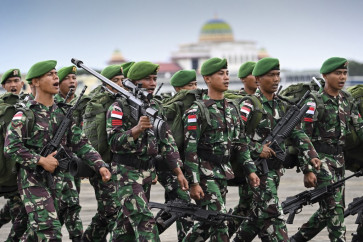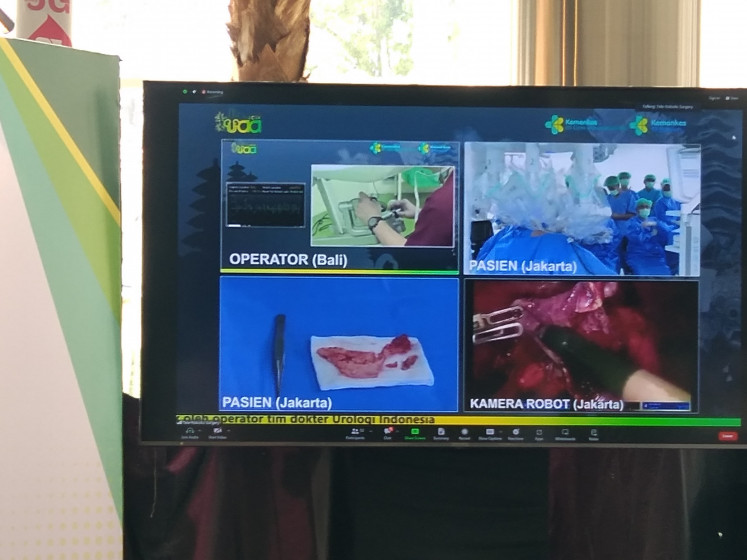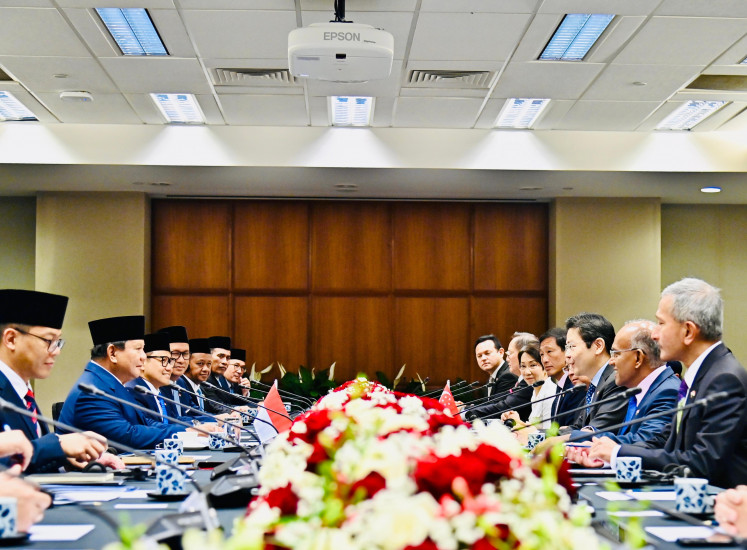Popular Reads
Top Results
Can't find what you're looking for?
View all search resultsPopular Reads
Top Results
Can't find what you're looking for?
View all search resultsLiquid locomotive: MRT expects Rp 60 billion in profit this year
Sopping wet: Motorcyclists take shelter in entrances to the Sudirman MRT station in Central Jakarta on Wednesday as heavy rain falls
Change text size
Gift Premium Articles
to Anyone

S
opping wet: Motorcyclists take shelter in entrances to the Sudirman MRT station in Central Jakarta on Wednesday as heavy rain falls. MRT Jakarta has booked Rp 60 billion (US$4.26 million) in profit after less than a year of operation.(JP/Dhoni Setiawan)
City-owned public transportation operator MRT Jakarta expects a profit of Rp 60 billion (US$4.26 million) to Rp 70 billion this year, mainly from ticket sales, ticket subsidies and non-farebox businesses.
MRT Jakarta president director William Sabandar said he was surprised to discover that income from non-farebox businesses quickly exceeded that of ticket sales.
That businesses include naming rights, advertisements and partnerships with telecommunication companies and retailers.
“From the non-farebox, we estimate that we will close 2019 with Rp 225 billion of revenue. That is larger than our estimated earnings from ticket sales, about Rp 180 billion,” he said on Wednesday.
“Most of our income, however, still comes from ticket subsidies, about Rp 560 billion,” he added, noting that the company also expected to earn Rp 40 billion more from bank interest.
Of the about Rp 1 trillion of revenue, William said the company would spend Rp 940 billion on its operational expenses by the end of the year. That leaves an estimated profit of Rp 60 billion.
William added said that of the total revenue from non-farebox businesses, 55 percent was from advertisements, 33 percent from naming rights, 9 percent from bank interest, 2 percent from partnerships with telecommunication companies and 1 percent from retailers.
There are currently five stations whose naming rights have been purchased by private companies. They are Lebak Bulus Station taken by ride-hailing app provider Grab, Blok M station by private lender BCA, Istora Station by state-owned lender Bank Mandiri, Setiabudi Station by Astra International and Dukuh Atas Station by state-owned lender BNI.
Each of those stations features the logo and promotional materials of the company that sponsors it.
“We’re in the process of selling naming rights for other stations, except ASEAN,” William said.
“We’re not selling the naming rights to ASEAN Station because they have been reserved by the government,” he added. He said the station, named after the ASEAN Secretariat building that stands across from it, could already sell itself.
If the number of daily passengers grows by 10,000 people each year and more partnerships with private companies are made, William said he was optimistic that MRT Jakarta’s profit could double or even triple.
He predicted the company would earn Rp 200 billion to 250 billion in revenue in 2020, Rp 300 billion to 350 billion in 2021 and would get ready to go public in 2022. He declined to elaborate further about the plan to go public.
“What I’m trying to say is that this is a great example of how railway-based transportation service is capable of making a profit, even in its first year of operation,” William said.
The popularity — and availability — of rail travel in Jakarta is growing. Greater Jakarta Transportation Management Body head Bambang Prihartono predicted it would be the future of urban transportation.
“Bus services are not sustainable. Rail transportation is the answer,” Bambang said earlier this month.
Aside from MRT Jakarta, the city also has commuter lines across Greater Jakarta operated by PT Kereta Commuter Indonesia (KCI), a subsidiary of state-owned railway company PT Kereta Api Indonesia (KAI). It also has LRT Jakarta in East Jakarta, developed by city-owned builder PT Jakarta Propertindo (Jakpro).
In next two years, Jakartans can expect to welcome LRT Jabodebek (Greater Jakarta LRT) developed by PT KAI, which will connect Jakarta with Bogor, Depok, Bekasi and Cikarang in West Java.
MRT Jakarta will soon begin its second phase of construction, from Hotel Indonesia traffic circle in Central Jakarta to Kota in West Jakarta. The new line will continue to West Ancol in North Jakarta where a train depot will be constructed.
The construction of this second phase is expected to be completed by 2024. Construction of the east-west line connecting Unjung Menteng in East Jakarta with Kembangan in West Jakarta is expected to begin in 2022.
Previously, MRT Jakarta finance and corporation director Tuhiyat said the company had another potential source of extra revenue: transit-oriented development (TOD).
As more pedestrian-friendly areas develop at public transit hubs through TOD, the company will collaborate with private enterprises from which it can collect more revenue.
“Based on the PRKs [urban design guidelines], we’re planning to build various facilities through TOD, such as affordable vertical housing, direct access to parks, buildings and public facilities offering more space for retailers and much more,” he said.
MRT Jakarta is the first city-owned company to be appointed to manage TOD by the city administration, as stated in Gubernatorial Decree No. 140/2017.
The company is waiting for the Jakarta administration to approve PRKs for five TOD cites along its first line, namely Dukuh Atas, Istora-Senayan, Blok M, Fatmawati and Lebak Bulus.









